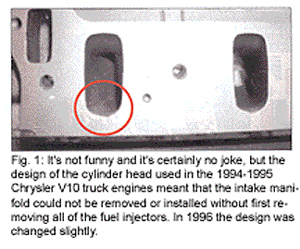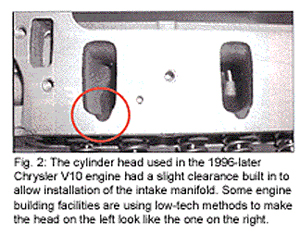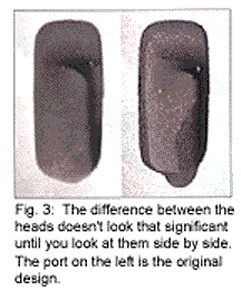By Roy Berndt
 "When is something you know not what you think you know?" Sounds like a mystery, doesn’t it? For example, when is a car not a car? When it turns into a parking lot!
"When is something you know not what you think you know?" Sounds like a mystery, doesn’t it? For example, when is a car not a car? When it turns into a parking lot!
I know, I know – don’t quit my day job. But that really IS my day job – dealing with mysteries and riddles. In this case, the riddle is the cylinder heads of the 8.0L, V10 Chrysler truck engine.
Although there aren’t nearly as many of the Chrysler V10 engines out in the marketplace as the Ford Triton V10s, there are enough of them that you have probably seen them show up in your building at some point. Since the engine’s life span was only 10 years and ended in 2003 they have now become "orphans" so to speak. Once that happens, you know for certain that someone is going to have to remanufacture this engine and its components.
Typically, either cylinder heads or crankshafts will begin arriving at your door before the complete engine will. To make things easier, we are going to talk about the cylinder heads – what you need to watch out for and what you can do about it. The best/worst part is that you only need to work with one casting number.

In 1994 the V10 truck engine, which was considered a derivative of the Viper engine, became the gasoline "big" horsepower/torque application choice over the diesel for those who harbored ill will towards the clatter, smell, smoke and huge cost. Before you start writing hate mail, no, I’m not diesel bashing, just stating the consumer facts.
The cylinder heads used in the 1994 and 1995 model year (MY) V10 applications were c/n 53005854. The intake port is the area where we want to focus our attention. Look at Figure 1 and examine the upper portion of the port as indicated by the red circle. As you can see there is a very minor clearance relief for the intake manifold-mounted fuel injectors. However, with this cylinder head, it is impossible to remove or install the intake manifold without removing all of the injectors. This obviously was not the plan when it came to servicing this engine.

In MY 1996, the cylinder head kept that same casting number without any suffix or prefix, however a change was made in the top of the intake port (see Figure 2) to allow intake removal and installation without having to remove all of the injectors. Based upon the number of calls that I’ve received from engine builders not being able to reinstall the intake manifold after changing cylinder heads I thought it prudent to let everyone know about that change. This change is almost unnoticeable at first until you lay the heads side by side (see Figure 3). Many of the facilities that I have spoken with are taking the Ram by the horns, so to speak, to eliminate part of this frustration. They are using dye and scribing the port relief shape at the top of the port. They then remove the material at the top of the port of the 1994-’95 cylinder heads so that they match the 1996-later head. By doing this they now have only one cylinder head part number that will allow assembly of the intake manifold assembly (with injectors) without the installer becoming frustrated.
This is one of those low-tech processes: it seems that everyone is just using a die-grinder and carbide burr to make the modification.
In this case, the answer to the riddle isn’t necessarily funny, but it will at least keep you smiling.
Article courtesy of ENGINE BUILDER magazine.













